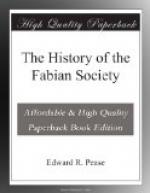The economical and moral identity of capital and interest with land and rent was popularly demonstrated by Olivier in Tract 7 on Capital and Land, and put into strict academic form by Sidney Webb. The point was of importance at a time when the distinction was still so strongly maintained that the Fabian Society was compelled to exclude Land Nationalizers, both before and after their development into Single Taxers, because they held that though land and rent should be socialized, capital and interest must remain private property.
This really exhausts the history of the Fabian Society as far as abstract economic theory is concerned. Activity in that department was confined to Webb and myself. Later on, Pease’s interest in banking and currency led him to contribute some criticism of the schemes of the currency cranks who infest all advanced movements, flourishing the paper money of the Guernsey Market, and to give the Society some positive guidance as to the rapid integration of modern banking. But this was an essay in applied economics. It may be impossible to draw a line between the old abstract deductive economics and the modern historical concrete economics; but the fact remains that though the water may be the same, the tide has turned. A comparison of my exposition of the law of rent in my first Fabian Essay and in my Impossibilities of Anarchism with the Webbs’ great Histories of Trade Unionism and of Industrial Democracy will illustrate the difference between the two schools.
The departure was made by Graham Wallas, who, abandoning the deductive construction of intellectual theorems, made an exhaustive study of the Chartist movement. It is greatly to be regretted that these lectures were not effectively published. Their delivery wrought a tremendous disillusion as to the novelty of our ideas and methods of propaganda; much new gospel suddenly appeared to us as stale failure; and we recognized that there had been weak men before Agamemnon, even as far back as in Cromwell’s army. The necessity for mastering the history of our own movement and falling into our ordered place in it became apparent; and it was in this new frame of mind that the monumental series of works by the Webbs came into existence. Wallas’s Life of Francis Place shows his power of reconstructing a popular agitation with a realism which leaves the conventional imaginary version of it punctured and flaccid; and it was by doing the same for the Chartist movement that he left his mark on us.
Of the other Essayists, Olivier had wrestled with the huge Positive Philosophy of Comte, who thus comes in as a Fabian influence. William Clarke was a disciple of Mazzini, and found Emerson, Thoreau, and the Brook Farm enthusiasts congenial to him. Bland, who at last became a professed Catholic, was something of a Coleridgian transcendentalist, though he treated a copy of Bakunin’s God and the State to a handsome binding. Mrs. Besant’s spiritual history has been written by herself. Wallas brought to bear a wide scholastic culture of the classic type, in which modern writers, though interesting, were not fundamental. The general effect, it will be perceived, is very much wider and more various than that suggested by Mr. Ernest Barker’s remark that Mill was our starting point.




